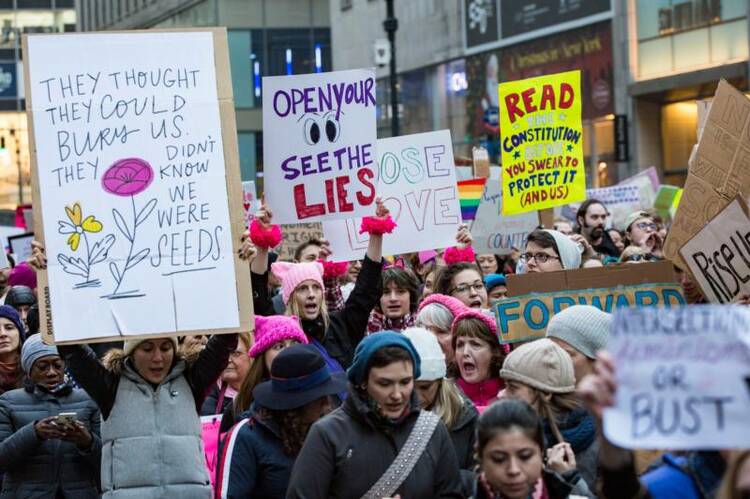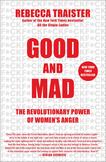Review: When wrath is not a sin
Almost 60 years ago, Valerie Saiving published “The Human Situation: A Feminine View,” a groundbreaking study of the concept of sin in which she argued that mainstream Christian theological understandings of sin depended on an androcentric (male-centered) understanding of human experience, an understanding that would change if the experience of women were taken seriously. Thinkers in this sexist framework had concluded that the root of sin was pride or overestimation of self, when in fact, for women, lack of self-worth or self-assertion was the central manifestation of sin. The essay remains a fundamental contribution to feminist theology because it hints at the many blind spots of a theology elaborated almost entirely by and for men.
Catholics learn early on that anger is a sin. One of the seven deadly ones, in fact—a real problem for the spiritual life. Children are taught to channel their anger productively by using language to diffuse situations of conflict, and we are encouraged to include those times when we have been angry in our examinations of conscience and trips to the confessional.
Rebecca Traister carefully notes the ways that white male anger is encoded in culture “as stirring, downright American, as our national lullaby,” while women’s anger remains shrill, toxic and an emotion that must be suppressed and removed from the public square.
Are Christians really anti-anger? Does this make us countercultural? After all, outrage is the order of the day, and we see evidence of this everywhere. Hate speech and violence are on the rise, and social media is rife with increasingly incendiary rhetoric. Twitter is, as the kids say, a “dumpster fire” of rage, bullying and threats.
Moreover, anger has been hailed as a frame to understand the contemporary political reality in the United States: It is the anger of the white working class at their seeming economic marginalization that pundits claimed in 2017-18 had propelled Trump to the presidency, and the mobilizing backlash of anger on the part of women, non-whites and other marginalized constituencies that resulted in a wave of women candidates winning local and national elections in 2018. The productive power of rage, especially the once-taboo manifestation of women’s rage, is the premise of Rebecca Traister’s Good and Mad: The Revolutionary Power of Women’s Anger.
Traister, a feminist and a journalist, traces how anger has shaped the American political imagination, from the righteous anger at tyranny expressed in the Revolutionary War through various waves of civil rights, the women’s movement and finally the Tea Party and #MeToo movements. Throughout, Traister carefully notes the ways that white male anger is encoded in culture “as stirring, downright American, as our national lullaby,” while women’s anger remains shrill, toxic and an emotion that must be suppressed and removed from the public square.
Traister also provides a power analysis of U.S. culture, particularly the ways in which an increase in the power of the marginalized (through economics or, more relevant, politics) prompts intense backlash from those who will lose standing and influence as a result: the white men who dominate our national discourse, our boardrooms and government buildings, our media landscape.
Rebecca Traister posits that anger can be both fruitful and generative, and that social movements that are born of the anger of the marginalized have proven successful time and again.
She cites examples, from the frequent portrayal of women politicians with their mouths open in an angry posture to the recurring debates about civility in public discourse, that underscore how we tend to ignore the initial violence of systemic marginalization, oppression and harassment, and instead zero in on and condemn the incivility of the reaction of the less powerful toward the more powerful in society. The Black Lives Matter protests, the #MeToo and #TimesUp movements all exemplify how violent structures and cultural mores (like police brutality in black communities or widespread sexual harassment in the workforce) are rendered invisible until the victims of this violence organize a response, which is then deemed frightening, violent or an overreaction.
With Audre Lorde’s foundational essay “The Uses of Anger” as a guide, Traister posits that anger can be both fruitful and generative and that social movements that are born of the anger of the marginalized have proven successful time and again in gaining more equitable power-sharing arrangements in politics and in the private sector. Further, she encourages women to refuse attempts to silence their anger:
What is bad for women, when it comes to anger, are the messages that cause us to bottle it up, let it fester, keep it silent, feel shame and isolation for ever having felt it or rechannel it in inappropriate directions. What is good for us is opening our mouths and letting it out, permitting ourselves to feel it and say it and think it and act on it and integrate it into our lives, just as we integrate joy and sadness and worry and optimism.
Though Good and Mad is not a work of theology, Traister’s mapping of the double standard of tolerance for men’s and women’s rage, and her profound analysis of the structural “first violence” (as Gustavo Gutiérrez would say of poverty) that marginalization represents, serves as an excellent conversation starter for those of us fighting marginalization and abuse in the church today. Perhaps one addition to Saiving’s 1960 essay on women’s “original sin” as lack of self-worth can be Traister’s prescription for liberation: embrace your anger, integrate it and let it fuel transformative action.
This article also appeared in print, under the headline “Days of Wrath,” in the May 13, 2019, issue.










